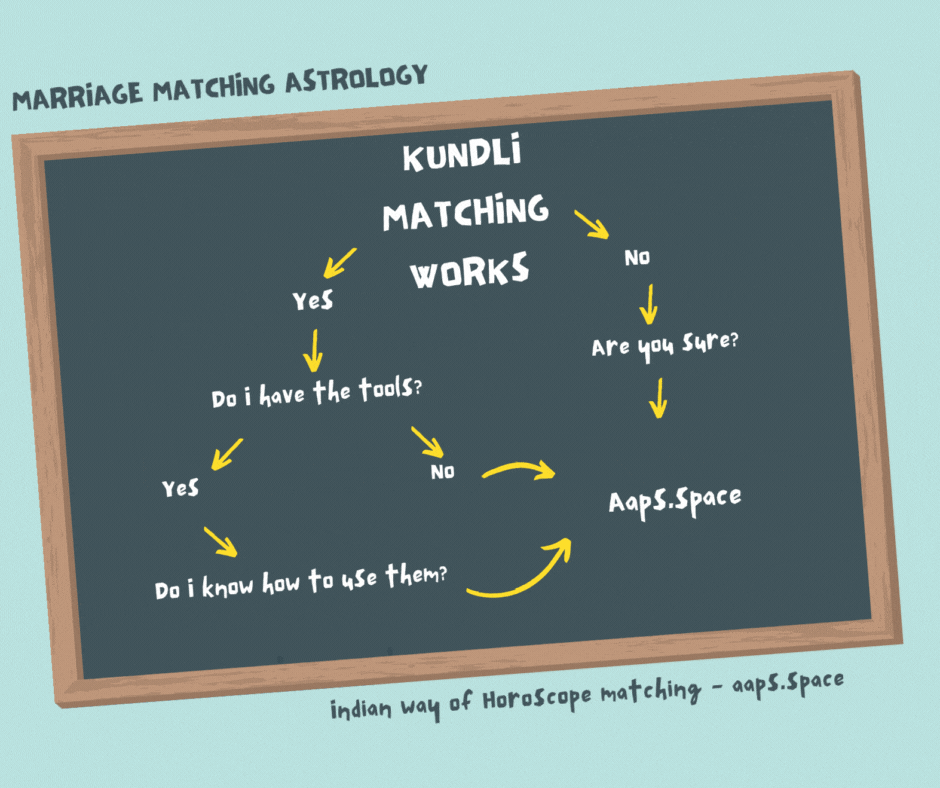Kundli matching Decoded
Kundli matching is the Indian way of horoscope matching. Kundli matching can be understood as a synastry of vedic astrology. Synastry is basically the matching of horoscopes of two people (husband and wife) in order to understand the future of relationship and compatibility.
In simple terms, Kundli matching can be understood as an indicator for the possible teaming up capabilities between two people.
For example, let us assume Marriage as a sport or a game where two people, the husband and wife, has to play in a team. The different type of compatibilities shows the combined skills of both of them in playing this game called marriage. Therefore a good horoscope matching score is always appreciated by an astrologer.
The types of kundli matching like Ashtakoot and Dashakoot are the methods of synastry. You can understand them as two formats of the same game. By any method, the end goal is to achieve a sustainable happy married life.
Reliability of Kundli matching for a happy Married life
People ask many questions when it comes to trusting the process of kundli matching for marriage compatibility.
For example, they ask like,
How many Guna should match in kundali matching for a happy marriage?
What is the importance of kundali matching for future married life?
I will try to answer these questions in the same way as I explained kundli matching.
We are thinking of a kundli matching score or Guna Milan score as an indicator of combined relationship skills between a bride and groom or husband and wife. Now as per our assumption, if marriage is considered as a game. And a consistent and ever sustainable happy plus joyful married life is something like your team (of you and your spouse) consistently winning each and every game. So the question is how much possible is that winning rate with any game no matter what type of skills to have?
The problem is whenever people think of kundli matching or horoscope matching they have very high expectations from the external factors and internal assumptions.
The importance of kundli matching in matching marriage is just like, the importance of your skills at a game in winning that game. Better skills increase the probability of you winning the game, but does not 100 per cent assures you of winning. In the same way, a better Guna Milan or kundli matching score increases your probability for a successful marriage but does not 100 per cent assures you a happy married life.
While on the flip side, the bad skills at the game make it very very hard for you to win the game. The same goes for kundli matching where a poor kundli matching score puts you at the risk difficult relationship and tough married life.
How much the marriage matching should rely on kundli matching?
From the marriage point of view, may it be a love marriage or arranged marriage, the kundli matching should only be used as a tool to understand the possible good and bad of a relationship. The compatibility from any kind of horoscope matching process is only - the ability of a couple to smoothly interact in their day to day married life. Therefore marriage compatibility or love life compatibility can be a valuable asset for a couple, but it can never assure them 100 per cent of sustainably happy married life. For that long term happy married life many other things will come into count.
What are doshas in kundali matching?
Doshas, in simple, are the defects or the shortcomings in the overall compatibility between couples. There are essentially the weak points in the overall compatibility. To pinpoint them and for a better understanding of these weak points, a relationship might have in future. They are specifically named. For example, Mangal dosha is caused by planet Mars and Nadi dosha is a shortcoming in Nadi koota or Nadi Porutham.
Two types of Kundali matching
In Indian astrology, there are two styles of Kundali matching used for compatibility analysis between a couple.
-
The Ashtakoot kundli matching with 36 points based matching, which is also called Guna Milan.
-
Porutham matching or Porutham kundali matching where 10 Poruthams are matched between the bride and groom. This method is also known as Dashakoot kundli matching.
Ashtakoot Kundali matching
Ashtakoot Kundli matching is the eight factor-based kundli matching method. In this method, 36 total points are distributed between 8 different factors of compatibility analysis. These 8 factors give an astrologer the knowledge about the different type of compatibilities between the bride and groom. The Ashtakoot Guna Milan is traditionally based on the planet Moon in astrology.
The 8 factors of Ashtakoot kundli Milan are called Kootas. They are listed below. (Note: Koota is pronounced as Koot.)
- Varna koota
- Vashya koota
- Tara koota
- Yoni koota
- Graha Maitri
- Gana koota
- Bhakoot or Bhava koota
- Nadi Koota
Dashakoot Kundali matching
Dashakoot kundli matching is the 10 factor-based kundli matching method. These 10 factors or principles on which the compatibility analysis of this method is based are called Kootums or Poruthams. Word Porutham is pronounced as "Poruttham". Kootum is another way to call Koota. The Dashakoot Kundali matching is also called Porutham matching.
The Porutham matching is also traditionally based on Moon in astrology. The ten generally accepted Poruthams are as follows:
- Nakshatra Porutham
- Gana Porutham
- Yoni Porutham
- Mahendra Porutham
- Stree Dirgha Porutham
- Rashi Porutham
- Rasyadhipati Porutham
- Vashya Porutham
- Rajju Porutham
- Vedha Porutham or Nadi Porutham
The Ashtakoot Kundli matching and Porutham matching
The table of similarity and differences between Ashtakoot Kundli matching and the Porutham matching approach.
| Ashtakoot matching |
Dashakoot matching |
| Popular synastry method in North India |
Popular synastry method in South India |
| Ashtakoot = Eight + Koota |
Dashakoot = Ten + Koota |
| There are eight compatibility factors in consideration |
There are ten compatibility factors in consideration |
| Both of them are Moon based match making |
| Total of 36 points are shared between 8 factors |
Total of 10 points (or 36 points depending upon approach) are shared between 10 factors |
| Variable weightage to Compatibility factors |
Equal weightage to all Compatibility factors in most common approach |
| The Compatibility factors or principles are called Kootas |
The Compatibility factors or principles are more popularly called Kutams or Poruthams |
| Both of them - Not a complete marriage matching tool |
| Both of them - Popularly used with overall Kundli analysis, Navamsa analysis and Mangal dosha analysis. |
| Origin - Northern parts of India |
Origin - Southern parts of India |


